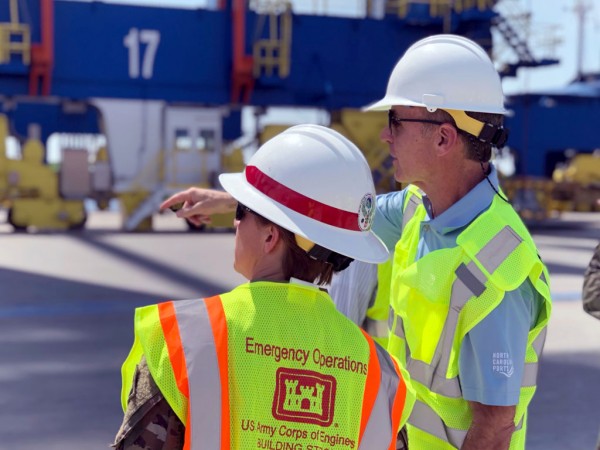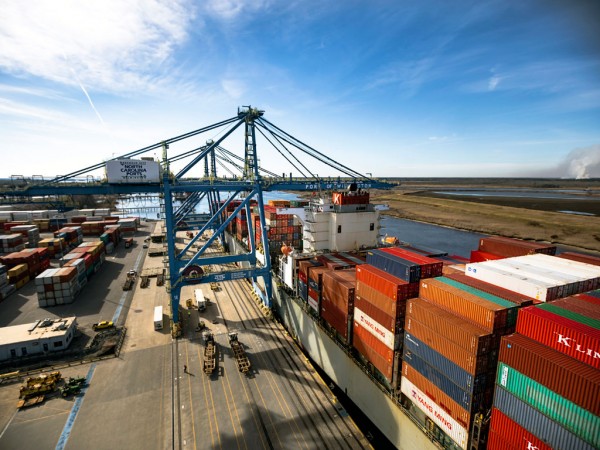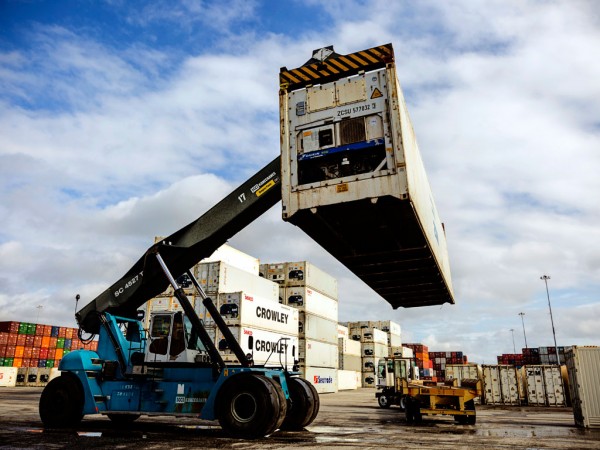Having swiftly recovered from Hurricane Florence, North Carolina’s Port of Wilmington is maintaining enviable efficiencies while handling record cargo flows through its enhanced facilities.
“As we continue to grow – and we are growing at substantial speed – maintaining productivity and the customer service element really is key for us, because that is what we view as our competitive advantage,” Paul J. Cozza, executive director of the North Carolina State Ports Authority, told AJOT in an interview this month.
All told, the North Carolina Ports’ aggressive expansion initiative encompasses $200 million in capital investments, highlighted by last spring’s arrival of two neo-Panamax cranes, with a third such ship-to-shore unit due next spring, to be put in place along nearly 2,600 feet of continuous berth to facilitate simultaneous accommodation of two neo-Panamax containerships. Further infrastructure improvements are in the works.

Pedestal-to-pedestal truck turn times for a drop-off are typically about 18 minutes at the Port of Wilmington, Cozza said, while a dual move for both drop-off and pickup is averaging 32 minutes. Meanwhile, each of the port’s neo-Panamax cranes has proven capable of 45 moves per hour.
“We really think that’s really best on the East Coast and the Gulf,” he said. “There is no question that is a very major contribution to the growth we’re seeing.
“We know we’re a smaller port compared to some of the others around us from the standpoint of pure volume, but gosh, something’s happening that we’re seeing this growth,” Cozza said, “and I think it’s squarely around that customers – both shipping companies and, more importantly, BCOs [beneficial cargo owners] – see us as a good part of their transportation supply chain.
“Within the Southeast, within the Carolinas, our pledge to both the carriers and the BCOs is to keep those productivity numbers,” Cozza said, noting that efficient truck movement has become increasingly important as trucking capacity is squeezed and drivers struggle to remain productive in an era of electronic-log-enforced hours of service. “We know it’s a real competitive advantage, and we’re going to keep as ‘Job 1’ that we keep those levels up on the water as well as on the land.”
Ocean carrier executives are clearly taking notice.
Recent service additions at the Port of Wilmington include all-water Asia service via the Suez Canal operating on ships of about 8,000- to 10,000-TEU capacity under a vessel-sharing agreement between ZIM Integrated Shipping Services and the 2M Alliance of Maersk Line and Mediterranean Shipping Co. And, Cozza said, another new service announcement may be expected soon.

Almost 1 million tons moved through the dual-domed wood pellet export terminal opened at the port in 2016 by Enviva Partners LP, which has its main production facility about 75 miles north of the port.
Projections indicate sustained overall growth as further infrastructure improvements advance.
Following up on the recent $30 million widening of the 42-foot-deep Cape Fear River turning basin to 1,400 feet from 1,200 feet, facilitating accommodation of boxships with capacity of as many as 10,000 TEUs, a second-phase turning basin project is under way, and port officials are working with the U.S. Army Corps of Engineers on a deepening program to take the channel to at least 45 feet.
“Our idea is to stay competitive with the ports around us,” Cozza said, explaining that precise future depth has yet to be determined.
Growing container volumes are being aided in their movement to and from inland points by the Queen City Express, which in mid-2017 began offering daily CSX rail service between the Port of Wilmington and Charlotte intermodal facilities.
“We’re working with CSX now on expanding the offering of that service,” Cozza said. “We’re seeing demand especially from the BCOs for the use of that around the Charlotte area.”
While activity as a whole is significantly up, the Port of Wilmington’s most impressive gains are taking place on the refrigerated cargo front, with the number of reefer lifts having tripled over the past three years. The boost has timed with the 2016 opening on the port of Port of Wilmington Cold Storage’s $17.5 million, 101,000-square-foot refrigerated warehouse.
Contributing to the volumes are exports of pork, poultry and sweet potatoes produced in the Carolinas and imports of bananas, berries and other fruits and vegetables, much coming from Latin America.

North Carolina Ports growth isn’t limited to Wilmington either. The bulk- and breakbulk-focused Port of Morehead City, about 100 miles to the northeast of Wilmington, has seen a 72 percent rise in volume over the past four years, reaching 1.7 million tons in the fiscal year ended June 30, 2018.
Significant inbound cargos at the Port of Morehead City include rubber, finished dimensional lumber and organic grains, while exports include grain from the Midwest, including that carried on Norfolk Southern unit trains.
The Port of Morehead City’s infrastructure is to get a shot in the arm in mid-2019 with arrival of a Liebherr LPS 420 rail-mounted gantry crane designed to handle bulk cargos, as well as warehouse enhancements.
With all those accomplishments and plenty to which to look forward, Cozza seems proudest of the fact that extensive preparation and coordination helped minimize damage from – and expedite return to normalcy following – Hurricane Florence, which made landfall about 10 miles from the Port of Wilmington on Sept. 14.
Cozza said he is pleased the port and its channel – in concert with the U.S. Army Corps of Engineers, the Federal Emergency Management Agency and others – were back up and running after seven days without vessel traffic.
“It was great to see how our team and our state responded,” he said, “and it was heartwarming to see the response we got from others in the maritime community, especially other ports.”




